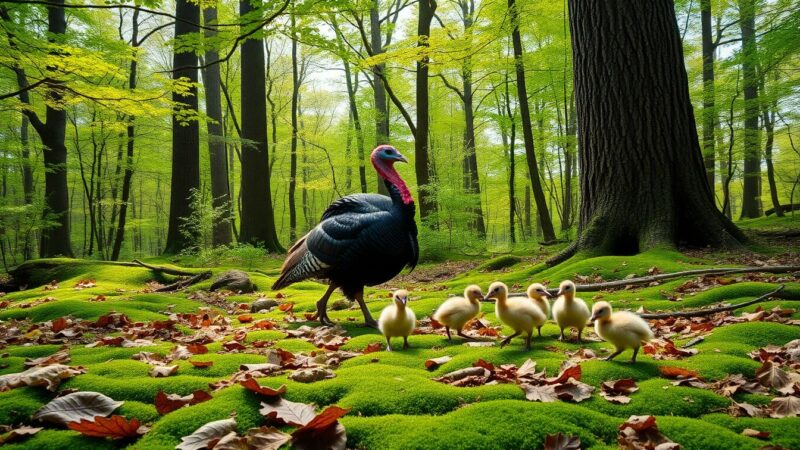Wild Turkey Life Cycle in Massachusetts

Introduction
Wild turkeys are a vital part of Massachusetts’ ecosystems and hunting traditions. They add diversity to forests, fields, and wetlands, making the state a prime spot for bird watchers and hunters alike. Knowing their life cycle helps us protect these birds and enjoy nature responsibly. From hatchlings in spring to flock formations in winter, understanding their seasonal behaviors is key for conservation and outdoor fun.
The Birth and Early Life of Wild Turkeys in Massachusetts
Incubation and Hatching
Wild turkey eggs typically spend about 28 days incubating in Massachusetts. Female turkeys, also called hens, build nests in dense grass patches, usually near forests or open fields. These nests are hidden to protect eggs from predators. Each clutch can have 10 to 15 eggs, but hatch success depends on factors like weather, predator presence, and food availability.
The Fledgling Stage
Once hatched, poults are tiny, fuzzy birds that rely heavily on their mother. They are camouflaged to hide from predators like hawks and foxes. Early life is tough for poults—they face many threats during their first weeks. Their survival depends on good cover and steady food sources. Experts say that poults stay close to their mother for protection and guidance.
Early Development and Growth
Poults grow fast, doubling their size within a few months. At first, they get nutrients from their yolk sacs, then switch to eating insects and seeds. Parental care remains critical during this stage. The hen teaches poults where to find food and how to stay safe. By summer’s end, they begin to look more like adult turkeys.
Juvenile and Subadult Stages
Transition from Poult to Juvenile
Around 3 to 4 months old, young turkeys start to gain independence. Their feathers change from fuzzy to more sleek, patterned plumage. They begin exploring wider areas, foraging on their own, but still stay close to the group. This transition is a crucial step toward full maturity.
Habitat and Behavior During Subadult Phase
In this phase, turkeys expand their range into new habitats like open fields and woodlands. They start foraging more aggressively and show more social behaviors. Flocks become less tight, and males begin showing dominance through displays and gobbling. Environmental factors such as food abundance and weather influence their growth and movement.
Adult Wild Turkeys in Massachusetts
Mating and Reproduction
Massachusetts’ wild turkey breeding season starts in spring. Males, or toms, perform striking courtship displays, puffing up and gobbling loudly to attract hens. A dominant tom usually gets the best females. Hens build nests, often laying 10-12 eggs, which they incubate for about 28 days. After that, poults hatch and begin their wild life.
Molting and Physical Changes
Every year, turkeys go through molting, shedding old feathers and growing new ones. This process typically occurs in late summer. During molts, their flying ability temporarily drops, making them more vulnerable. Full feather regrowth takes several weeks, and molting marks a key point in their physical development.
Territorial Behavior and Group Dynamics
Male turkeys are known for gobbling loudly to establish dominance and defend their territory. Males often compete in displays and fights. Females tend to stay in groups called flocks, especially in winter, to increase safety. Habitat fragmentation can make these social behaviors more complex, forcing birds to adjust their movement and interactions.
Seasonal Movements and Habitats
Migration Patterns in Massachusetts
Most wild turkeys in Massachusetts are year-round residents, but some are partial migrants. During winter, they move to places with easier access to food, like fields or wooded areas. In spring, they return to breeding sites. These movements aren’t long-distance like some other birds, but they are essential for survival.
Preferred Habitats Throughout the Year
Turkeys thrive in a mix of hardwood forests, open fields, and wetlands. These areas provide food, cover, and nesting sites. Conservation efforts focus on protecting these habitats from destruction. For outdoor lovers and hunters, knowing where turkeys are during different seasons helps in observing their behaviors and planning hunts responsibly.
Conservation Status and Human Impact
Current Population Trends in Massachusetts
Massachusetts reports healthy turkey populations, thanks to conservation efforts. Still, challenges remain, such as habitat loss and hunting pressure. Diseases like avian flu can also impact numbers. Continued monitoring and habitat preservation are key to maintaining healthy populations.
Conservation Initiatives and Regulations
State and federal programs work to protect wild turkeys through habitat restoration and hunting regulations. Permits are required for hunting, and seasons are set to control harvest. These rules help ensure long-term turkey sustainability.
How People Can Help
You can contribute to wild turkey conservation by supporting local projects that restore habitats. Practice responsible outdoor behavior—avoid disturbing nests and flocks. Reporting sightings helps monitor population trends. Supporting policies that protect forests and open spaces benefits these birds.
Conclusion
The wild turkey’s life cycle in Massachusetts follows clear stages: from egg incubation, to poults’ first adventures, to mature birds establishing territories. Understanding their seasonal behaviors allows us to appreciate and protect them better. Whether you’re a hunter, bird watcher, or nature lover, respecting their habitat and supporting conservation efforts helps secure their future. Get involved, keep your eyes open, and enjoy observing these fascinating birds thrive in our community.

